South Lands Almanac - February 2025
Late Summer
Wheel & Cross is proud to publish this monthly Almanac at the start of each month. It was created to observe and understand the cycle of seasons in the Australian Capital Region, through the lens of European agricultural knowledge and publicly available and openly shared knowledge of the traditional custodians of ‘Capital Country’, the Ngunnawal.
I acknowledge that the Ngambri people also claim custodianship of these lands. Unfortunately, I do not have any Ngambri cultural information regarding language, connection to Country or seasonal customs. This means I am unable to share anything relating to Ngambri culture but I am always keen to learn.
I pay my respects to all First Nations Elders, past and present and to all First Nations peoples from around Australia and the Torres Strait Islands who are the proud custodians of this Country we all love.
Contents
Important Dates
Ngunnawal Season - Winyuwangga
Weather and Climate
January weather summary
Long-range forecast
Natural emergencies
Star Gazing and Star Lore
Moon phases - Berry Moon
Visible planets, meteors and solar movements
Western and First Nations ‘star lore’ - Canis Major and Sirius
Nature and Environment
Useful weeds - Blackberries and Hawberries
Native flora - Grasses, Climbing Saltbush and Black Kurrajong
Native fauna - Corroboree Frog
In Season - seasonal crops, flowers and food
Important Dates
1 February - Lughnasadh
Lughnasadh is an ancient agricultural celebration of the ‘First Harvest’, the grain harvest. Many folk customs surround the harvest of the last sheaf, making Corn Dollies and celebrating with feasts, fairs and games. In Ireland, this time of year was marked with celebrations honouring Lugh, the Celtic god of the harvest, and his foster mother Tailtiu, who is said to have cleared the land for farming in Ireland. Athletic games and competitions, such as wrestling, horse racing, archery, or chess honoured Lugh's talents and abilities, as well as being an opportunity for some communal fun. Handfasting and weddings at this time of year were considered auspicious. Find out more on the Wheel & Cross article, Episode 31 - Lughnasadh: The First Harvest (Harvest of the Grains).
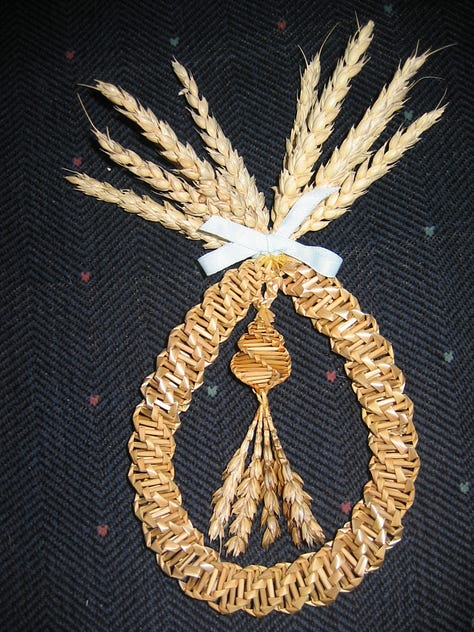
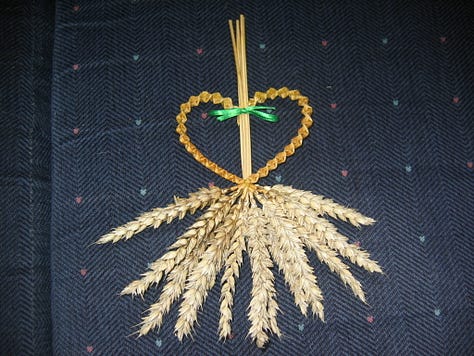

Ngunnawal Season - Winyuwangga
Sources: Tyronne Bell, Ngunnawal Elder, Thunderstone Cultural Aboriginal Services
The Australian Capital Region is part of the Southern Tablelands. It has a cool temperate climate featuring warm to hot and dry summers and cold winters with heavy frosts and radiation fog. February marks the third month of the four-month Ngunnawal season of Winyuwangga. Native edible grass, rush and wattle seeds are abundant during Winyuwangga. Bushfires are easily sparked by dry lightning, sparks from cooking fires or spontaneous combustion (usually hot composting material).
See January’s article for more information about the region’s pre and post-colonial ecosystem and Firestick cultural practices.
Weather and Climate
Sources: Australian Bureau of Meteorology, WeatherZone.com.au, Timeanddate.com, Weather Spark
Weather Summary - January
Storm events on the south coast of eastern Australia resulted in above average rainfall. Much of Australia experienced heat waves in January though the Australian Capital Region escaped the worst effects and regions to the east of the ACT experienced average summer temperatures. Soil moisture in our region was average to above average in January and water storage volume was 80% or above across the region.
Max Temp - The average maximum temperature for January this year was 29°C, higher than the long-term average of 27°C. The highest maximum temperature was 37.5°C recorded on 28 January.
Min Temp - The average minimum temperature for January this year was 13.7°C, close to the long-term average of 14°C. The lowest minimum temperature for the month was 6.6°C recorded on 8 January.
Rainfall - It rained on 8 days in January with a total of 70.2mm, compared with the January average of 8.3 days and 55.9mm of rain. The highest amount of rain fell on 16 January with 17.8mm.
Long-Range Forecast
The Australian Bureau of Meteorology’s long-range forecast for February to April predicts that most of the country, including the Australian Capital Region, is expected to receive higher-than-average rainfall. Streamflows in our region are expected to be near medium or high. Daytime temperatures will be slightly warmer than average for this region and time of year. Nighttime temperatures are expected to be warmer than average across the entire country with a high chance of unusually high temperatures in our region. Consistently hot nighttime temperatures result in heatwaves that can be deadly so please be prepared.
Sea Surface Temperatures (SST) are forecast to remain warmer than average, especially in the southeast of the country. Warm oceans increase the amount of water and energy in our atmosphere, which increases the severity of storms and rainfall events. Warmer ocean temperatures also cause acidification and coral bleaching events.
Averages for the Australian Capital Region in February are:
Maximum Temperature 28°C
Minimum Temperature 14°C
Rainfall 65mm and 8.3 days of rain
Natural Emergencies - Fires, Floods, Heatwaves and Storms
Extreme heat has caused more deaths in Australia than any other natural hazard and has major impacts on nature and the environment. Ensure that plans are in place to survive extreme heat events including redundancies for power outages as extreme heat can impact the electricity grid.
The statutory Bush Fire Danger Period for Rural Fire Districts began on 1 October. Fire Permits are required throughout most of NSW including the Goulburn-Mulwaree, Queanbeyan-Palerang, Snowy Monaro and Yass Valley regions of NSW, and in the Australian Capital Territory. Make sure you understand your fire risk, prepare your homes and properties for the fire season, have a bush fire survival plan and pay attention to Fire Danger Ratings for your area. Visit the NSW Rural Fire Service (NSW RFS) and ACT Emergency Services Agency (ACT ESA) websites for more information.
Increased storm activity and higher-than-average rainfall inundation events are likely to lead to increased chances of local flooding and storm damage. Prepare your homes for the storm season, prepare flood, and storm survival plans, and pay attention to severe weather warnings. Visit the NSW State Emergency Service (NSW SES) website for more information.
The Australian Institute for Disaster Resilience and the National Emergency Management Agency have developed the Australian Warning System to “provide information and warnings during emergencies like bushfire, flood, storm, extreme heat and severe weather.” There are three warning levels:
Advice (Yellow) - An incident has started. There is no immediate danger. Stay up to date in case the situation changes.
Watch and Act (Orange) - There is a heightened level of threat. Conditions are changing and you need to start taking action now to protect you and your family.
Emergency Warning (Red) - An Emergency Warning is the highest level of warning. You may be in danger and need to take action immediately. Any delay now puts your life at risk.
The NSW Hazards Near Me app provides access to current information and notifications from emergency services about local emergencies. Be sure to download it and set your ‘Watch Zones’.
Star Gazing and Star Lore
Sources: Time and Date, The Lighthouse - Macquarie University, SciTech, Australian Indigenous Astronomy, The Conversation
Lunar Phases
Wednesday 5th - First Quarter Moon (waxing) - Rise 1:40pm ENE, Set 11:58pm WNW
Thursday, 13th - FULL MOON (Berry Moon)* - Rise 8:31pm ENE, Zenith 1:23am N, Set 6:48am WNW
Friday, 21st - Last Quarter Moon (waning) - Rise 11:31pm (20 Feb) ESE, Set 2:38pm WSW
Friday, 28th - New Moon - Rise 6:37am ESE, Set 7:54pm W
*The names of the full moons provided here generally correspond with names used in old English agricultural calendars and similar American Almanacs, although they have been re-arranged according to their appropriate season in the southern hemisphere. See Full Moon Names for the Southern Hemisphere for more information.
Stars, Planets and Meteors
Not all stars in the night sky are scientifically stars. True stars comprise the vast number of what we call ‘stars’. They appear to twinkle as their light comes from active suns in distant solar systems. The other celestial bodies we call ‘stars’ are planets in our solar system visible from Earth. They shine steadily in the night sky rather than twinkle as they steadily reflect the sun’s light, rather than producing their own light.

Seven planets will be more or less aligned in the skies at the beginning of this month. Mercury will be visible for the first time but it will be hard to spot as it rises low in the western sky just after sunset. Uranus and Neptune will need a telescope to be seen. At the end of the month, Venus and Saturn become lost in the glare of the Sun.
MERCURY - becomes visible again at the start of the month in the western sky at sunset but is difficult to see in the setting sun’s glare.
VENUS (also known as ‘The Evening Star’) - is in the eastern sky and will become increasingly difficult to see in the setting sun’s glare before it disappears from the night sky at the end of the month.
MARS - is visible in the northeastern sky during the evenings.
JUPITER - the largest planet in our solar system continues to move slowly through Taurus in the northern sky.
SATURN - is also visible in the eastern sky and will disappear into the sun’s glare by the end of the month.
METEORS - The Alpha Centaurids meteor shower will reach its peak on February 8, though it only produces a few meteors per hour and the bright Moon will make them difficult to see.
Constellation Feature - Canis Major ‘The Great Dog’
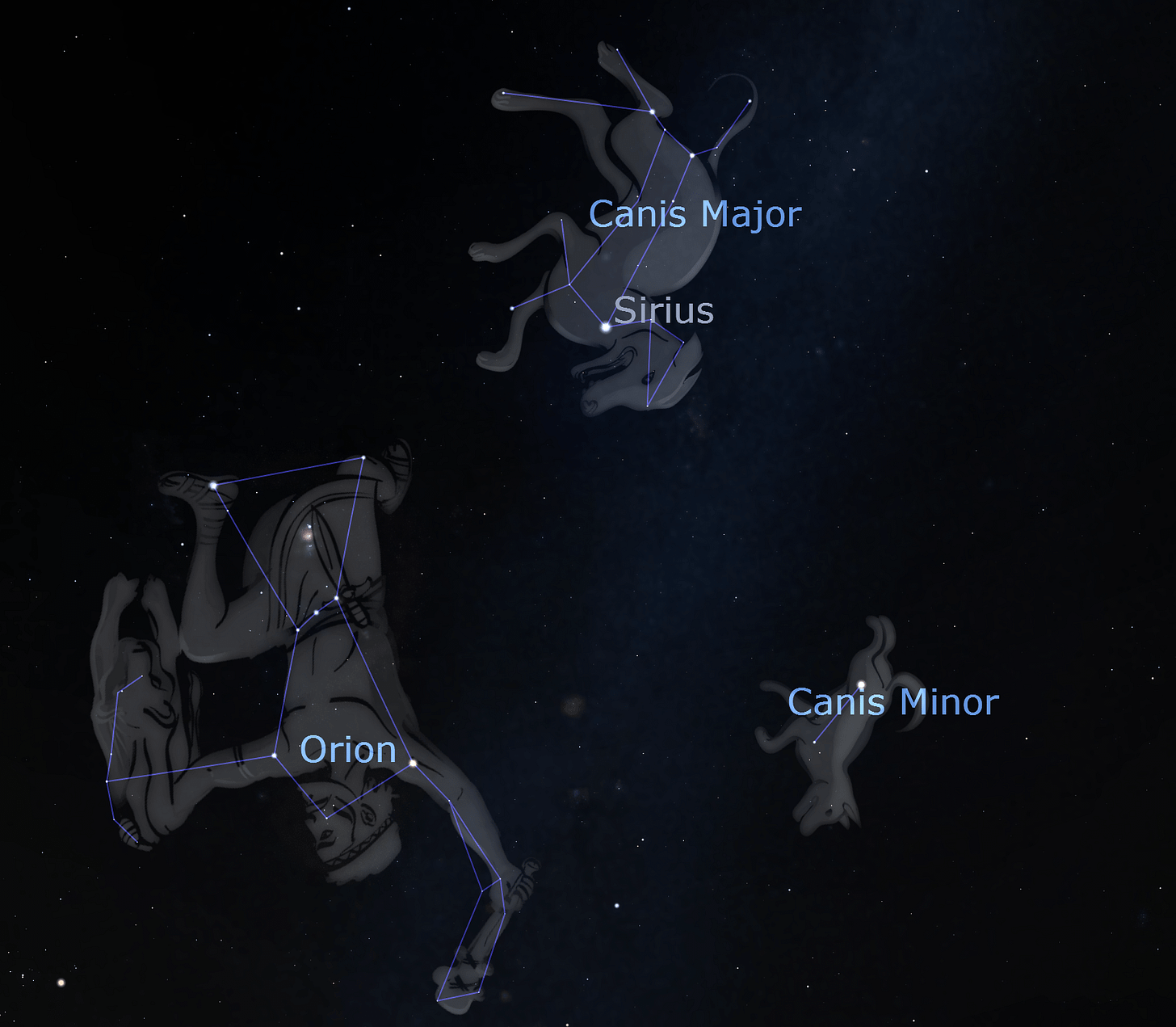
Canis Major contains two important stars. VY Canis Majoris is a red hypergiant star and one of the largest stars discovered so far. Sirius (Alpha Canis Majoris) is the brightest star in the night sky and is actually a binary star system (two-star system). It consists of a main star twice as massive as our Sun, orbited every 50 years by a white dwarf star.
Sirius is significant for many cultures around the world. In ancient Egypt, the appearance of Sirius in the sky corresponded with an important event that was vital to survival, the flooding of the Nile River. It was called the ‘Dog Star’ by the ancient Greeks due to its prominent position in the Canis Major constellation. Its appearance during the hottest days of summer gave rise to the term ‘dog days’. In ancient Mesopotamia, the Babylonians considered Sirius to be an arrow aimed at Orion, with the bow consisting of the southern stars of Canis Major and a part of the Puppis constellation.
Canis Major was seen by the ancient Greeks as Orion’s hunting dog, helping him to fight Taurus the bull or pursuing Lepus, the hare. Orion’s second hunting dog Canis Minor was added to the story by ancient Romans. Canis Major also appears in ancient Greek mythology as Lealaps, the fastest dog in the world, destined to catch anything it pursued:
Zeus gave Laelaps to Europa as a present, along with a javelin that could not miss. The gift proved to be an unfortunate one, as Europa herself met her end at the hands of her husband Cephalus, who was out hunting with the javelin.
Cephalus took the dog to Thebes in Boeotia (a Greek province north of Athens) to hunt down the Teumessian fox that was causing some trouble there. Like Laelaps, the fox was very fast and was destined to never be caught. Once the dog found the fox and started chasing it, the chase did not appear to have an end in sight… Zeus himself finally ended the chase and turned both animals to stone. He placed the dog in the night sky as the constellation Canis Major, the Great Dog.
Ancient Islamic scholars referred to Canis Major as Kalb al-Jabbar “The Dog of the Giant”. Māori recognised both Canis Major and Canis Minor as distinct entities that formed a larger constellation called Te Huinga-o-Rehua, or Te Kahui-Takurua, (“The Assembly of Sirius” where Rehua and Takurua referred to Sirius).
In Australia, Canis Major appears during the summer months. Three stars in Canis Major formed the constellation Munowra in the star lore of the Tharumba people of the Shoalhaven River.1 These stars were Wunbula (Bat) and his two wives Murrumbool (Mrs Brown Snake) and Moodtha (Mrs Black Snake). Murrumbool and Moodtha became bored of following their husband around so they tried to bury him while he was hunting a wombat down its burrow. Wunbula speared the women, and all three were raised into the sky.
These same stars were viewed differently by the Boorong people of Victoria.2 Sigma Canis Majoris was known as Unurgunite, flanked by his two wives, the stars Delta and Epsilon. Mityan (‘quoll’), the moon fell in love with Unurgunite’s furthest wife (Epsilon) and tried to lure her away but Unurgunite found out and a great fight erupted. Mityan was defeated and has been wandering the sky ever after with the battle scars still visible on his face.3
The Boorong also placed Sirius in the centre of the constellation Warepil, the male wedge-taled eagle, chief of the elders who created the land, called the Nuh-rum-bung-goo-tyas. Warepil’s wings spread out across less bright stars on either side of Sirius. Orion’s bright star Rigel is called Collowgullouric Warepil, Warepil’s wife.4
Other Constellations
Southern Cross (Crux) - rising in the sky and moving towards its upright position from its southeast side. More information in the January issue.
The Twins (Gemini) - rising from the northeast in the afternoons and setting in the northwest as day breaks. More information in the December 2024 issue.
Scorpion (Scorpius) - More information in the November 2024 issue.
The Bull, the Warrior and the Seven Sisters (Taurus, Orion and the Pleiades) - More information in the October 2024 issue.
Sky Emu - rising diagonally, head and neck will be visible near the end of the month. More information in the September 2024 issue.
Nature and the Environment
Most of the information provided about native seasonal flora and fauna is relevant to the cool climate region in Australia’s south, particularly the Australian Capital Region, and can be found in the book, ‘Ngunnawal Plant Use: A Traditional Aboriginal Plant Use Guide for the ACT region,’ and the ‘Ngunnawal Seasonal Calendar’ by Ngunawal Elder and traditional custodian, Tyronne Bell from Thunderstone Aboriginal Cultural Services.
Useful Weeds (Food/Medicine)
Blackberries (Rubus fruticosa) - Blackberries are ripening across our region, and will normally provide a bountiful and delicious harvest until the end of March. They were brought to Australia by British colonisers and though their prolific fruit are a good source of food, their vigour and hardiness has caused serious adverse impacts on agriculture, tourism and native ecologies.
Blackberry has already cost around $100 million to control and in lost production. It quickly infests large areas; forms dense thickets that restrict stock access to waterways and access via fire trails; takes over pastures; is unpalatable to most livestock; reduces native habitat for plants and animals; fuels bushfires; provides shelter for rabbits and foxes, and; provides food for introduced species such as starlings, blackbirds and foxes
Blackberries are now considered a Weed of National Significance, requiring ongoing management practices and long term control. The NSW Department of Primary Industry a WeedWise profile for Blackberry with more information.
European folktales often feature blackberries as symbols of abundance and sometimes caution. According to folklore from the British Isles, fairies are said to guard blackberry bushes. Those who respect the plants and the faeries are rewarded with bountiful harvests. Conversely, picking berries after a certain date, most often Michaelmas on September 29, is said to invite misfortune, as it's believed that the fruit will be blighted by the devil.
This belief comes from a Christian folktale in which Archangel Michael defeated Archangel Lucifer and threw him out of Heaven into Hell. Lucifer, the Devil, landed on a patch of blackberries, causing him much pain. He cursed the blackberry fruit and spat (or peed in some tales) on them, causing the berries to blight. And so it is that berries should no not be eaten from Michaelmas Day. Although this is a Christian tale, there is buried within it old wisdom to avoid eating blackberry fruit after the first frosts as they will likely be spoiled and tasteless. For those of us in the southern hemisphere, that date translates to March 29 and to the first frosts of the winter season.
Blackberries were also said to have transformational powers. In Eastern European stories, blackberries often serve as magical agents that can change one's fate. A Polish folktale narrates the journey of a young man who, upon eating a mystical blackberry, gains the ability to understand animals' speech, leading him to uncover hidden treasures.
Although Blackberry is considered a significant noxious weed in Australia, it also has some benefits in addition to its edible fruit. Its blossoms support pollinators in spring, its thick brambles provide food and shelter for native animals and birds such as bandicoots and blue wrens, its leaves are used in herbal medicines and it makes an landscape barrier in hedgerows.
Hedgerows are liminal places, living fences of tangled wildness, in contrast to the ‘civilised’ and domesticated landscapes that they often bound. They serve as property boundaries, field borders, livestock barriers, and wildlife havens and can be seen crisscrossing the countryside throughout the British Isles, part of its agricultural landscape for centuries. In Britain, their use can be traced back to the Bronze Age and they gained prominence during the Enclosure Acts of the 18th century when they were used to divide open fields and commons into individual plots.
Typically, hedgerows are composed of a variety of plants that provide nectar from flowers in Spring, shelter and shade in summer, and fruit (many edible but some poisonous) from late summer to autumn. They include shrubs like hawthorn, blackthorn, and hazel, and trees such as crab apple and elder. The undergrowth often contains brambles such as blackberry, ferns, herbs and a carpet of wildflowers – each species contributing to a dense and diverse ecosystem.
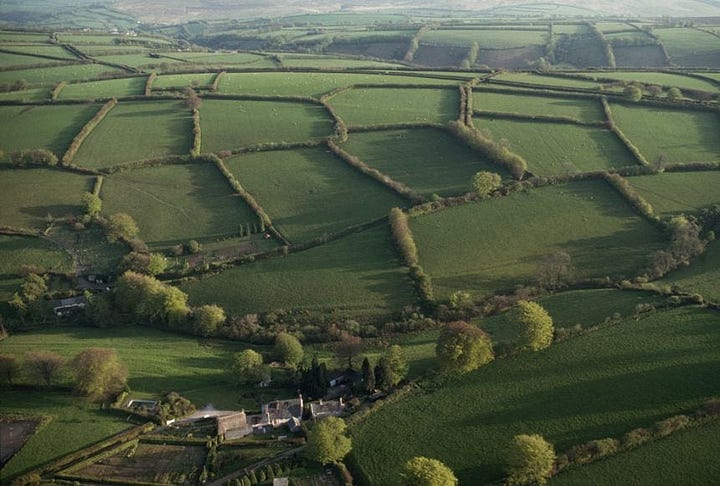
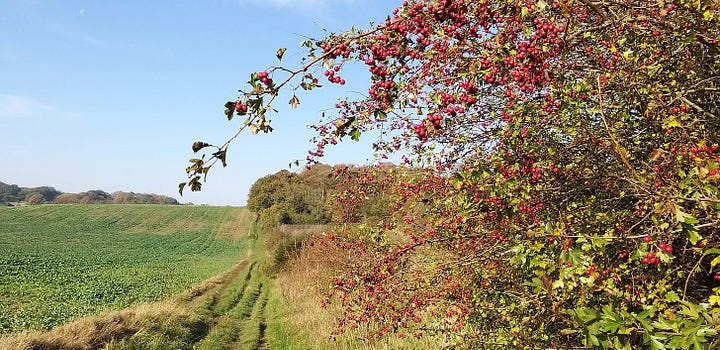
Hawberries (Cratagus spp.) - Hawthorn forms the backbone of many hedgerows. We don’t often see formal hedgerows in Australia but hawthorn (and cottoneaster) are very common in our region, following lines of fencing along roadsides. In late summer and early Autumn, the small haw berries ripen to bright red and though they are edible, the aren’t particularly palatable. They are often used to make jams and jellies or dried and infused in herbal teas. Just be careful not to confuse it with cottoneaster berries, which are poisonous to people, dogs and livestock.
In Western Herbal and Chinese Medicine the berries are used to help with cardiac issues such as irregular heartbeat, congestive heart failure, high blood pressure, and chest pain, as well as for digestive ailments. They are also used to help with emotional states related to heartbreak and loneliness.
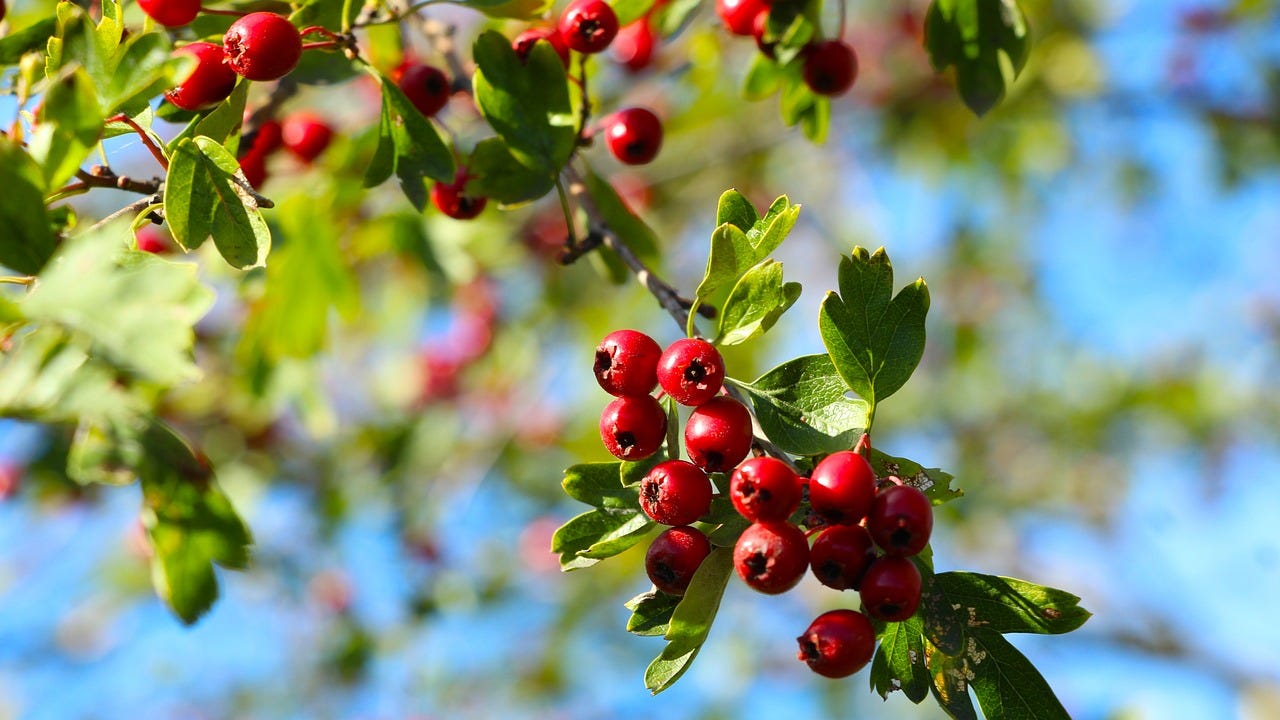
Hawthorn is a particularly important plant in folklore and is considered a sacred plant in many European cultures. Across the British Isles and particularly in Ireland, hawthorn was considered home to the faeries, also called the Good People, Sidhe, or Aos Sí. Lone hawthorn trees in a field or by a spring were especially charmed and sacred. Even in this day and age farmers are reluctant to bulldoze or cut these lone trees and roads have been re-routed to avoid causing any damage to the trees. The hawthorn tree was particularly important in the spring celebration of Beltane, where it was often referred to as the May Bush and you can find out more about this in the Wheel & Cross podcast and article, Episode 23 - Beltane (Earth): A-Maying, The May Bush and May Poles.
Native Flora
Native Grasses
Australian native grasses are a diverse group of plants that have evolved over millions of years in Australia’s harsh and varying climate. Flour from native grains, such as millet, kangaroo grass and Mitchell grass, were important to many First Nations cultures and survival for thousands of years before colonisation. Their deep root systems and perennial growth have many environmental benefits, such as preventing soil erosion, increasing groundwater recharge, and supporting native biodiversity.
Native millet (Panitum decompositum), in particular, was found to be easy to grow and harvest, easy to grind into flour, significantly more nutritious than wheat, and gluten-free. ‘Kangaroo Grass’ (Themeda triandra) can also be used for flour in the same way as wheat, has 40 per cent more protein than wheat, and is apparently quite tasty. It also stores more moisture than European crops and creates its own micro-climate in which native insects thrive.
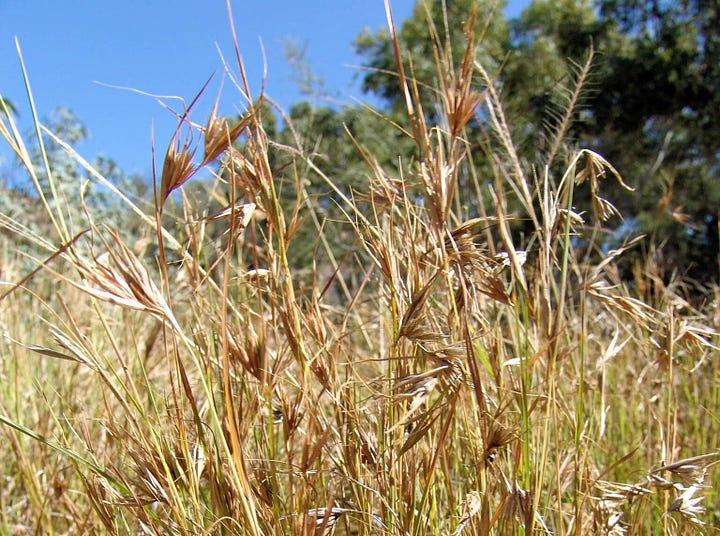
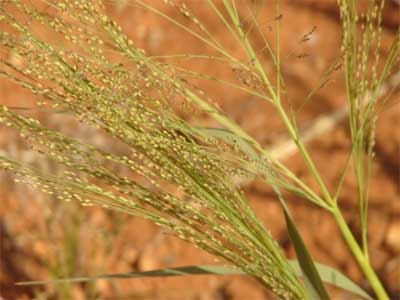

These articles provide more information on the use of native Australian grasses for cereal cropping
ABC News (2022) - Native grains harvest brings together culture, food and regenerative farming
ABC News (2021) - Could native crop, kangaroo grass, become a regular ingredient in bread and help farmers regenerate land?
The Guardian (2020) - Australian researchers find native grasses could be grown for mass consumption
Climbing Saltbush (Chenopodium/Einadia/Rhagodia nutans) - Tiny red berries of Climbing Saltbush are ripening around our region. Its fruit are sweet and edible, though too small to provide much sustenance to humans. However, they are an important food source for native birds and lizards.
Black Kurrajong (Brachychiton populneus) - The Kurrajong is a large tree bearing cream to pinky flowers from October to January, growing into large black seed pods in February. It is an important tree for the Ngunnawal people and is widely used as a source of food, fibre and water. Water is obtained from the tree roots. Young shoots can be roasted and eaten. Seeds from seed pods in late summer can be eaten raw or roasted. Jelly-like sap can be eaten. Bark can be made into string and rope for use in nets, fishing lines and dilly bags.



Native Fauna
Southern Corroboree Frogs (Pseudophryne corroboree) and Northern Corroborree Frogs (Pseudophryne pengilleyi) - Corroborree Frogs are breeding this month, having started their season in January. These brightly coloured yellow and black striped frogs are endangered and unique for several reasons. They secrete a poison from their skin to protect them from skin infections rather than from predators. This poison is self-produced rather than accumulated from food sources like other poisonous frogs. They also take four years to reach sexual maturity and breed in terrestrial nests rather than in the water.
Males sing their squelch-like song to attract up to ten females into his burrow one at a time. Females lay around 38 eggs in the terrestrial nest of moss or other soft vegetation and then the male deposits sperm directly onto the eggs. Tadpoles develop but remain within the egg until the winter rains flood the area, and then hatching occurs.
Metamorphosis takes place in December through February and lasts six to eight months. As the juveniles grow, the adults hibernate during winter, another peculiar behavior of the corroboree frog. Dispersing into the surrounding woodlands, shelters include snow gum trees, bits of bark, or fallen leaves.
The Ngunnawal have a dreaming story about how the Corroborree Frog came to be. This story is available as a children’s book, Dyirri the Frog, told by Ngunnawal Elder, Don Bell and published by Brolga Press. It can be purchased at Thunderstone.
Grain Harvest
Source: Grainwise.com.au
The southern region winter grain crop harvest finished at the end of January: Barley, Canola, Cereal rye, Chickpeas, Faba beans, Field peas, Lentils, Lupins, Oats, Safflower, Triticale, Vetch, Wheat (according to type and weather).
The 1st of February marks the ancient Celtic celebration of Lughnassadh, First Harvest or Harvest of the Grains. You can find more information on the Wheel & Cross episode and article, Episode 31 - Lughnassadh: First Harvest (Harvest of the Grains).
Flowers
Sources: Meadow and Widler Farm, What Cut Flower is That
Flowers finishing this month: Agapanthus (Agapanthus spp.), Blazing Star (Liatris spicata), Cantebury Bells (Campanula medium), English Lavender (Lavender augustifolia), Gladioli (Gladiolus hybrids), Hydrangea (Hydrangea spp.), Larkspur (Delphinium spp.), Lillies (Lily hybrids), Marigold (Tagetes erecta), Sea Holly (Erygium spp.), Stocks (Mathiola incana)
Flowers starting this month: Chrysanthemum (Chrysanthemum spp.)
Flowers continuing this month: Ageratum (Ageratum spp.), Amaranth (Amaranthus spp.), Aster (Aster spp.), Baby’s Breath (Gypsophila paniculata), Belladonna Lily (Amarylis belladonna), Bells of Ireland (Molucella laevis), Cock’s Comb (Celosia spp.), Cornflower (Centaurea spp.), Cosmos (Cosmos bipinnatus spp.), Dahlias (Dahlia hybrids), Echinacea (Echinacea purpurea), Gladioli (Gladiolus hybrids), Hollyhocks (Alcea and Alcathaea spp.), Lavender - French (Lavendar dentata), Lisianthus (Eustoma spp.), Marigold (Tegetes erecta), Peruvian Lily (Alstromeria aurantiaca), Pincusion (Scabiosa caucasica), Roses (Rosa spp.), Sea Holly (Eryngium spp.), Smokebush (Cotinus spp.), Statice (Limonium spp.), Sunflower (Helianthus annus), Zinnia (Zinnia spp.)
Kitchen Garden
Source: Food Tree
Herbs - Basil, bay, chives, coriander, dill, mint, oregano, parsley, rosemary, sage, thyme
Vegetables - Capsicum, celery, chilli, cucumber, celery, eggplant, kale, lettuce (cos, iceberg), onion (brown, red and white), pak choy, pumpkin (butternut), salad greens, spinach, spring onion, silverbeet, sweet corn, sweet potato, zucchini. Butternut pumpkins will be ready to harvest mid-month.
Fruit - Blueberries, summer-bearing raspberries and blackberries are at their peak. Autumn-bearing raspberries are about to start. Strawberries, red and black currents, and apricots are winding down. Cherries are coming from Victoria and Tasmania, winding up at the end of the month. Nectarines and Peaches peak in January and February. Late season plums peak this month. Table grapes (white, red and black) reach their peak this month. Valencia oranges and limes are in season. Rockmelon and watermelon are at their peak this month.
Ridley, William (1875). Kámilarói, and other Australian languages (PDF) (2nd ed.). Sydney, New South Wales: T. Richards, government printer. pp. 144–45.
Smyth, Robert Brough (1878). The Aborigines of Victoria: with Notes Relating to the Habits of the Natives of other Parts of Australia and Tasmania. Melbourne, Victoria: J. Ferres, government printer. pp. 433–34.
Hamacher, Duane W. (2018). Stars renamed in recognition of Aboriginal astronomy, Australian Geographic. Online. [access 1 February 2024].
Morieson, John. (1966). The Night Sky of the Boorong: Partial Reconstruction of a Disappeared Culture in North-West Victoria. [Masters Thesis]. University of Melbourne. pp.27-28.


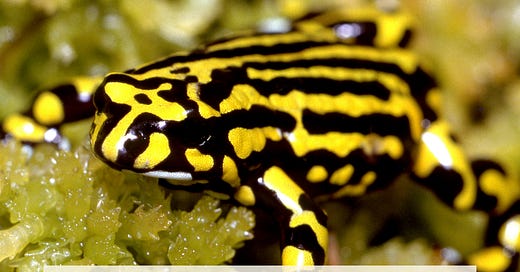



I do enjoy going through these wonderful collections of information. Thank you for sharing all your research, and for doing it in such an appealing and easy to read way.
I took particular note of your section on blackberries this time through, with a hint of nostalgia, remembering a childhood where going blackberrying was a much loved pastime (although I think far more went inside us than made it home for Mum to put in pies!). Occasionally I buy a punnet of 'blackberries' from the supermarket, but they aren't really blackberries - and it isn't the same as heading out with a bucket! I was excited to discover that there is actually a native blackberry which is less invasive, but I don't think most people can tell the difference so they get poisoned, anyway :(
Anyway, I do love reading your almanac, and refer back to the information regularly (as well as look forward to the next)!